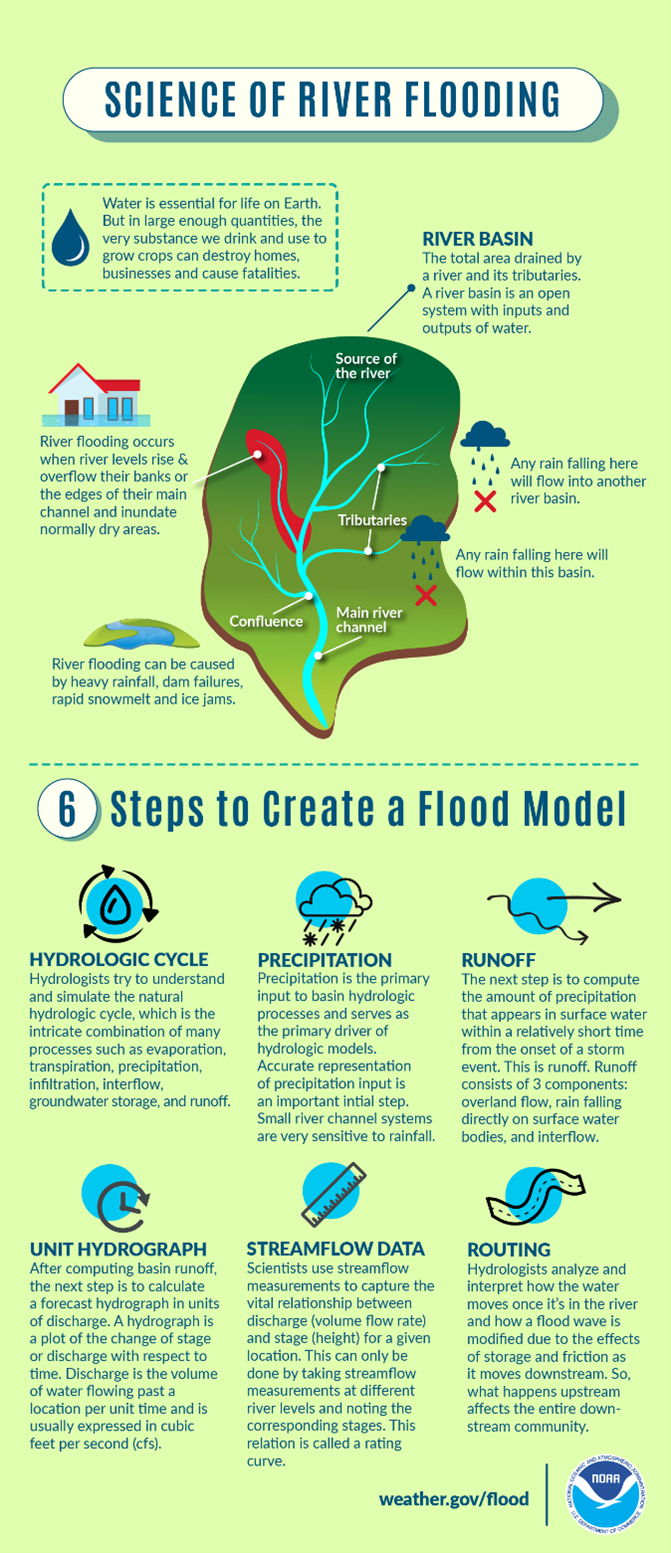 When a river’s watershed receives more rain than it can handle, water levels rise and overflow into surrounding areas called floodplains. These areas are nature’s way of holding excess water and slowing floodwaters, which reduces impacts downstream. The most common type of flooding in our area is Riverine Flooding, which happens when rivers or streams overflow due to heavy rainfall. Flooding can develop gradually or occur suddenly during flash floods. Natural or man-made obstructions in floodplains can make flooding worse by forcing water to back up or overflow further.
When a river’s watershed receives more rain than it can handle, water levels rise and overflow into surrounding areas called floodplains. These areas are nature’s way of holding excess water and slowing floodwaters, which reduces impacts downstream. The most common type of flooding in our area is Riverine Flooding, which happens when rivers or streams overflow due to heavy rainfall. Flooding can develop gradually or occur suddenly during flash floods. Natural or man-made obstructions in floodplains can make flooding worse by forcing water to back up or overflow further.
Why Floodplain Management Matters
Floodplains do more than hold water. They also:
- Improve water quality by filtering pollutants
- Support wildlife and biodiversity
- Reduce damage to homes, roads, and infrastructure
- Protect drinking water sources
While floodplains serve important ecological functions, they also present flood risks to people and property. To manage these benefits and risks, the Town of Wake Forest regulates development in the floodplain through its Unified Development Ordinance (UDO). The Flood Damage Prevention Ordinance places limitations on man-made changes in floodplains. A Floodplain Development Permit must be applied for before any changes to the floodplain can be made, from large scale development to minor changes like fences, pools, and sheds. Visit the Floodplain Development page for more information.
What is a Flood Zone?
Flood risk is divided into zones designated by FEMA. These zones help identify areas at higher risk of flooding. Every property falls within a specific zone, but no property is completely safe from flooding. Risk may increase over time due to climate change, development, or updated flood maps. Flood maps may change and areas previously considered low risk may become flood-prone due to climate change, urban development, or updated mapping. Use the tools on the Know Your Flood Hazard page to better understand your property’s flood risk.
Flood Insurance
Standard homeowners’ insurance does not cover flood damage. However, residents can purchase federally subsidized flood insurance through the National Flood Insurance Program (NFIP) even if their property isn’t in a mapped floodplain. Wake Forest qualifies for the NFIP by adopting and enforcing regulations that meet or exceed federal standards.
Protecting Wake Forest
The main purpose of floodplain regulations is to create, and protect, areas that can hold floodwater and lower the likelihood of severe flooding in developed areas. This prevents costly repeat flood losses to homes, businesses, roads, and critical infrastructure. Beyond flood control, maintaining natural floodplains is essential for protecting water quality, acting as natural filters by trapping pollutants and sediments before they reach drinking water resources. By enforcing responsible floodplain development practices, the Town of Wake Forest can enhance public safety, protect natural resources, and reduce the long-term financial burden of flood disasters. For more information on floodplain regulations, visit the UNC School of Government Local Floodplain Regulations FAQ.
